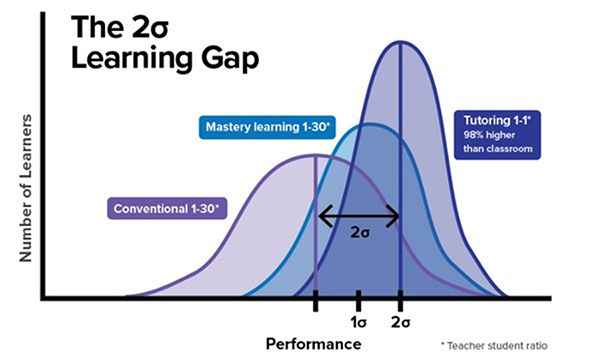 What the time of “intelligent interrogation” means for today’s workforce.
What the time of “intelligent interrogation” means for today’s workforce.
Artificial intelligence (AI) is transforming education and learning – changing how we learn inside and outside of school, the workplace and other formal and informal settings.
Since the introduction of generative AI (GenAI) model in November 2022 and the release of the large language models (LLM), such as ChatGPT 4 in March 2023, and its later variations including ChatGPT 4o and ChatGPT 4o Mini on top of other GenAI apps and tools, the speed of the transformation is ever increasing.
The future best-in-class learning is expected to use AI-powered assistants and AI agents that are contextually aware of and fully integrated with the learning environment to deliver personalized, one-on-one guidance and feedback to learners at scale. The anchor term herein is “at scale.” The ready availability of GenAI and its continued development and advancement will propel new teaching and learning pathways, leading to heightened efficiency and effectiveness of on-campus learning, lifelong learning, professional upskilling and reskilling.
Decades of research show that the traditional, one-to-many model of teaching and learning is not the most effective way to learn. Educational psychologist Benjamin Bloom1 observed that students who learned through one-on-one tutoring outperformed their peers by two standard deviations; that is, they performed better than 98% of those who learned in traditional classroom environments. The superiority of one-on-one tutoring over classroom learning has been dubbed the 2 sigma problem in education (Figure 1).

Figure 1. The 2 sigma problem demonstrates that students who learn under one-on-one tutoring environments outperform peers who learn in traditional classrooms.
Based on the findings of this research, AI – when used properly and effectively – could continue to transform our teaching methodologies and techniques, as well as learning conduits, online or in-person. First let us think about how we learn.
Learning processes. We learn through a variety of sources, platforms and processes, which can be segmented into five tiers:
- Exposure
- Awareness
- Understanding
- Application
- Teaching.
These five tiers, in ascending comprehension and learning capacity, feed each other and work circularly over time. For example, when we are exposed to an unfamiliar environment, we become aware of something new, intendedly or unintendedly. With exposure, we gain awareness, then understanding, and eventually apply it to our life and work. With robust learning and knowledge accumulation, we may be progressing and advancing into the capacity to teach.
When we teach, we learn through exposure and interact with a variety of audiences, offering compounded awareness and understanding – a full circle!
Learning does not stop at graduation or earning an academic degree. In today’s technology-driven, fast-moving and competitive world, we must continue to learn on the job to reskill and upskill our expertise to meet new demands. In the AI era, the need for continued learning and lifelong learning is more intense than ever.
The AI Factor.2 In view of the dynamic landscape within the US and globally in the AI era, changes in skill requirements on the job call for new and ongoing workforce development. The US Bureau of Labor Statistics expects demand for AI engineers to increase 23% by 2030. Job postings that call for skills in GenAI increased an incredible 1,848% in 2023, according to a Lightcast labor market analysis, and there was phenomenal growth (over 385,000 postings) for AI roles in 2023.
The current imbalance in supply and demand of AI talents creates new opportunities. Per Elon Musk: “The competition for AI engineers is the craziest talent war I’ve ever seen.”3 Lucrative jobs offering “a million bucks” in the battle to hire AI talent is not unheard of.4
Job seekers, beware! There may be a booby trap. Companies are deploying more bots to sort through the oceans of applications. Relying on ChatGPT to compose resumes to specifically match job descriptions aiming to pass corporate screening software may not lead to desired results.
Here is an anecdote: A company urged job seekers to refrain from using AI to fill out the online applications. One prompt asked applicants about the pros and cons of software-development methodologies, and then added something the company figured only the bots would “ignore:” “If you’re reading this, awesome – do not answer this question.” More than a quarter of the applications answered it anyway.
AI is changing the job landscape. The availability of AI engineers and AI talents is crucial to the prosperity and security of the nation going forward.
Jobs. Is the fear justified that AI, particularly GenAI, takes jobs away? If so, to what extent and which types of jobs are highly exposed? On the other hand, would AI augment human abilities and capacities to enable us to do our jobs easier or more efficiently? In this regard, views and perspectives span widely and disparately.
As AI algorithms are expected to efficiently read and summarize research, business, medical and legal documents into bullet points, allow researchers to “intelligently interrogate” the information, develop content for marketing and sales, and draft computer code based on natural-language prompts, many believe that knowledge workers/white-collar professionals will feel more pain this time around, especially in some levels of IT service, customer service, human resources, legal service, marketing and sales. Leveraging the power of AI, some functions in research, development and engineering could also be streamlined or automated. Many new jobs are being created, however, such as prompt engineers, AI cybersecurity jobs and GenAI-savvy jobs.
Indeed, some job functions can be handled, in whole or in part, by well-tuned AI models and apps. Nonetheless, as of now, some high level of cognitive “intelligence,” such as abstract thinking, judgment, intuition, aesthetic taste, leadership, sensitivity, empathy and emotion, self-awareness, consciousness, spirituality and faith, philosophical thinking, and complex reasoning and problem solving, among others, are still the sole domains of humans.
All in all, we are in the AI era that creates both augmentation and automation – when using GenAI tools “correctly” – offering more efficiency to our work and lives while causing inevitable changes and uncertainties that, in turn, provide both challenges and opportunities.
Buckle up, because the pathway to learn new technologies, master new skills, gain basic knowledge on AI and leverage new AI tools to capture the opportunities and meet the challenges in the AI era is a sagacious one.
Ed: The author will present on AI opportunities and challenges at SMTA International in October 2024.
References
- Benjamin S. Bloom, Educational Researcher, 13, no. 6, June-July 1984, pp. 4-16.
- Jennie S. Hwang, “Artificial Intelligence – Opportunities, Challenges, and Possibilities,” professional development course, IPC Apex Expo 2024 and SMTA International 2024.
- Gareth Vipers, “Elon Musk Boosts AI Engineer Pay in ‘Craziest Talent War,’” The Wall Street Journal, Apr. 5, 2024. (https://www.wsj.com/tech/ai/elon-musk-tesla-boosting-engineer-pay-in-ai-talent-war-e8390c0b)
4. Katherine Bindley, “The Fight for AI Talent: Pay Million-Dollar Packages and Buy Whole Teams,” The Wall Street Journal, Mar. 28, 2024. (https://www.wsj.com/tech/ai/the-fight-for-ai-talent-pay-million-dollar-packages-and-buy-whole-teams-c370de2b)
Dr. Jennie S. Hwang, CEO of H-Technologies Group, is a pioneer and leader in SMT manufacturing since its inception and in developing and implementing environment-friendly lead-free electronics technology and manufacturing; This email address is being protected from spambots. You need JavaScript enabled to view it..








 What the time of “intelligent interrogation” means for today’s workforce.
What the time of “intelligent interrogation” means for today’s workforce.





